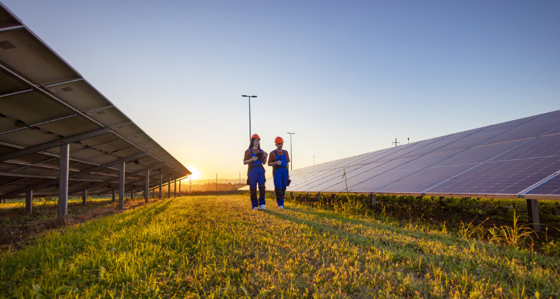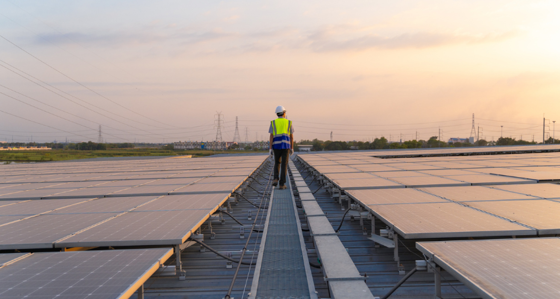
Collaborate to innovate: overcoming blockers to decarbonisation at scale
5 min read 9 April 2024
At Baringa’s fourth Green Buildings and Transport Forum on 5 March 2024, we tackled two important areas on the low-carbon journey: vehicle-to-everything (V2X) and green retrofit.
On the V2X side, we discussed our UKPN Park & Flex project with Fermata Energy, which is looking at unlocking the potential of using EVs in public car parks to help power the grid. Then, we debated The Great British Retrofit – a new Baringa report collaborating with TrustMark, Travis Perkins, and the University of Warwick – which explored supply chain challenges and how to address them.
Although V2X and green retrofit are different, we identified common challenges to overall mass-market enablement:
- lack of policy clarity
- low consumer engagement
- green skills gaps
- lagging standards adoption
- supply chain constraints.
Let’s delve into these issues and the solutions we discussed.
V2X and green retrofit would benefit from more policy clarity…but we can’t afford to wait
There was general frustration at the lack of Government policy to drive these initiatives forward at pace. The challenge to retrofit at scale is significant, needing robust policies that provide consistency and drive investment at the required levels.
However, as one attendee noted, “There’s lots of inertia from people waiting for policy. We can’t wait. There’s a huge opportunity for industries to collaborate and drive system-wide change – even without a clear policy framework.”
There’s lots of information out there… but we’re not resonating with consumers
Shifting the dial on domestic decarbonisation has been a common theme at our forums (read more in this article). Despite the wealth of available information, people struggle to understand what solutions they need, how to use them, and how they’re tailored to their lifestyle.
How do we get that “what’s in it for me” message to cut through?
Our lively debate identified three focus areas:
1. Speak the consumer’s language
We must distinguish between industry terminology and language that resonates with consumers – and ensure we’re using the right language in the right contexts. For instance, while the term ‘retrofit’ is widely used and understood within the industry, our attendees' anecdotal experiences showed that consumers don’t find it enticing. ‘Retrofitting’ sounds expensive, disruptive, and impersonal, whereas the term ‘home improvement’ resonates in a much more positive way.
This was backed up by research by co-sponsored by TrustMark, which suggested that, in the able-to-pay market, ability to access finance or loans isn’t the primary barrier to domestic decarbonisation. The primary barrier is access to good advice and competent installers. People are willing to pay where they are able to see energy efficiency and low carbon installations as a home improvement that makes their homes warmer and reduces ongoing costs. Nudging homeowners to consider this when they are making home improvements or refurbishments can deliver the change we need in the UK.
The same goes for commercial property. Talking to landlords about “improvements to make properties more lettable” has yielded better results than leading with an ESG conversation.
We need to make a more conscious effort to speak the consumer’s language to achieve the necessary impact.
2. Offer the right incentives
In our attendees’ experiences, free money in isolation doesn’t work with decarbonisation propositions. For example, there’s limited take-up on heat pump grants from financial institutions because people say they aren’t in the mood to spend money (even at the subsidised amount), and the perceived disruption isn’t worth it.
We need to identify the right incentives, which is what the Park & Flex project is doing for V2X.
The project is preparing to launch a first-of-its-kind public vehicle-to-grid trial at an airport car park to understand consumer appetite and drivers. After all, consumers don’t care about energy markets or balancing mechanisms. And they certainly don’t care about reducing car park operators’ energy bills.
Claire Weiller, director of European strategic partnerships and product at Fermata Energy, explained how the trial is seeking to find the incentives that deliver the most perceived value. “When a customer with an eligible EV books into the car park, we will present different reward options, such as airport shopping discounts, airport lounge access, parking upgrades, and free battery top-ups. This will help us understand the optimal business case.”
3. Consider the entire customer journey
The earlier in the customer journey we start educating people, the easier the process becomes. We need to find the entry point in order to get consumers interested in something the vast majority don’t yet know they need – and do so in an engaging way.
Then, we can leverage trigger events to drive action. For example:
- Going on holiday – From the V2X perspective, this is a time when drivers know they won’t need their car. As long as it has enough charge to drive home, it’s a low-friction opportunity for a reward.
- Buying a new property – People are more likely to consider installing a heat pump at this point of major change, and the cost seems small when framed against a house purchase. Lenders can leverage this opportunity.
- Considering general home improvements – With the right training, builders can take a whole-house approach, using the opportunity to design a more energy-efficient solution.
Yes, there are green skills gaps…but collaboration can help close them
Our research found that the construction industry is grappling with a green skills gap of approximately 270,000 tradespeople. The gap rises when you add the skills for other areas, like installing bidirectional EV charging solutions for V2X.
However, Andy Rayner, director of apprenticeships at Travis Perkins, brought an interesting perspective: “There’s a misconception that we need a whole raft of new trades. We don’t. It’s about doing things slightly differently and adapting what we teach people to do. It comes down to collaboration to standardise training and boost awareness around the value of green skills as a long-term career choice.”
Standards are moving slowly…but there is steady progress
Combined Charging System (CCS) is the ISO standard for charging EVs and includes provisions for V2X bidirectional charging. Although this standard has been published, charging and EV manufacturers haven’t fully implemented it. This causes issues with immediate, off-the-shelf interoperability.
Avinash Rajan, proposition director at TrustMark, also highlighted that data insights can help confirm that home improvements are delivered to required standards. “There are multiple organisations that require installers to capture data on home improvements. Often, these are legal, regulatory, or certification requirements. Many of these are individual data lakes and siloed. The real value comes from being able to break down the silos and aggregate data at an individual property level, so it can be standardised and shared to benefit of all stakeholders,” he explained.
On the green home improvement side, this would give homeowners a single way to understand what’s been done in their property. Lenders and insurers could access this record, too, enabling them to assess risk more accurately. Initiatives such as the Open Data Interchange (ODI) and Open Property Data Institute are working on this “data liquidity” challenge, and the more industry stakeholders who get involved, the greater the speed and mutual value.
Supply chains face constraints…but that shouldn’t hold back innovation
Supply chain dynamics will always exist, no matter the level of market maturity. The immediate challenge is overcoming barriers to scale.
David Mackenzie from Baringa discussed how scale will help drive down prices and create “a virtuous circle where consumers get more value, which then drives more demand. Without consistent government policy stimulating investment, we must seize the opportunity to innovate. Creating new UK innovation hubs, investing in circular economy approaches, and integrating best practices from other countries is essential.”
The Park & Flex project is a perfect example of taking the initiative in this way. Our phase one research found that V2X has the potential to unlock 4.3GW of flexible capacity and £6.6 billion of value across UKPN’s area alone. And the landmark airport car park trial in phase two will help develop a scalable business model, despite current constraints on the availability of compatible vehicles.
“Many EVs with the required bidirectional charging are slow to come to market to market, which is a huge restriction for scaling V2X at the moment,” explained Claire Weiller from Fermata Energy. “However, the learnings will help with scaling because the trial is tech-agnostic. Once we understand the optimal business case and customer journey, we are in a stronger position for when more EVs arrive.”
Where can you help collaborate and innovate?
Collaboration was a central theme in addressing challenges related to policy, consumer engagement, skills, standards, and supply chains.
The idea behind the Great British Retrofit thought leadership piece was sparked from a previous forum, where Baringa, TrustMark, and Travis Perkins discussed the interconnected barriers to domestic decarbonisation. There are huge opportunities from bringing industry players together to collaborate on other viewpoints around decarbonisation.
Park & Flex is just one of Baringa’s UK Research and Innovation (UKRI)-funded projects. We’re also working with other partners on issues like unblocking heat decarbonisation in high-rise buildings, determining the value of thermal flexibility, and ensuring a fair energy transition.
UKRI have £450 million to spend on Strategic Innovation Fund projects, so think about your challenges and talk to us about how we can design projects to address them.
Collaboration and innovation will drive progress against a backdrop of policy uncertainty. So let’s get some momentum. Contact Rebecca Vallance to start a conversation on this.
Our Experts

Related Insights

Dissecting the REMA decision
Three years in the making, the Review of Electricity Market Arrangements (REMA) decision has now been published: the UK Government has decided to retain the national wholesale price.
Read more
What might a reformed GB national power market look like under REMA?
Discover how a reformed national market is likely to include significant changes to current market arrangements, with material impacts for market participants.
Read more
Investing in uncertainty: European power market outlook 2025
Our latest outlook points to a more uncertain energy transition, shaped by political and economic volatility across Europe in the form of Trade Wars, Populism and Remilitarisation.
Read more
REMA and investing in GB power market under uncertainty
Learn about the opportunities and challenges of investing in the GB power market under uncertainty and how Baringa can help
Read moreIs digital and AI delivering what your business needs?
Digital and AI can solve your toughest challenges and elevate your business performance. But success isn’t always straightforward. Where can you unlock opportunity? And what does it take to set the foundation for lasting success?